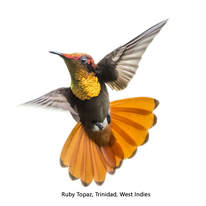|
The ruby-topaz hummingbird (Chrysolampis mosquitus), commonly referred to simply as the ruby topaz, is a small bird that breeds in the Lesser Antilles and tropical northern South America from Colombia, Venezuela and the Guyanas, south to central Brazil and northern Bolivia; also from Colombia into southern Panama. It is the only member of the genus Chrysolampis. It is a seasonal migrant, although its movements are not well understood.
This hummingbird inhabits open country, gardens and cultivation. It is 8.1 cm long and weighs 3.5 g. Compared to most other hummingbirds, the almost straight, black bill is relatively short. The male has green-glossed dark brown upperparts. The crown and nape are glossy red, and the throat and breast are brilliant golden-orange. The rest of the underparts are brown, and the chestnut tail is tipped black. The male often looks very dark, until he turns and the brilliant colours flash in the sunlight. The female ruby-topaz hummingbird has bronze-green upperparts and pale grey underparts. The tail is chestnut with a dark subterminal band and a white tip. Females from Trinidad typically have a greenish throat-streak (it may appear dark), but this is not common elsewhere in its range. Juvenile females are similar to adult females, but with a white-tipped dusky-brown tail. Juvenile males resemble the juvenile female, but with a variable amount of iridescent orange to the throat. The female ruby-topaz hummingbird lays two eggs in a tiny cup nest in the fork of a low branch. Incubation takes 16 days, and fledging another 18 or 19. The food of this species is nectar, taken from a wide variety of flowers, and some small insects. Ruby-topaz hummingbird males perch conspicuously and defend their territories aggressively. The call of this species is a high-pitched tsip. Ruby Topaz photographed by Rachel Lee Young in the RAPSO garden, Diego Martin
0 Comments
Leave a Reply. |
AuthorRachel Lee Young. Photographer Archives
January 2020
Categories |


 RSS Feed
RSS Feed
